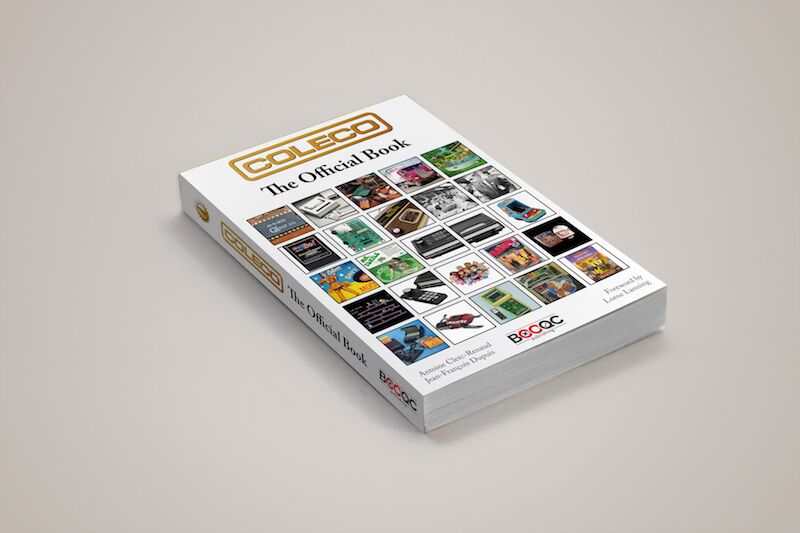As a retro gamer, there is a lot of history to take in that all began with the simplest concept of the video game. Pioneers in bringing these games to home televisions, Coleco is a name many know to be around during the age of Atari and woodgrained consoles. Coleco – The Official Book, written by Antoine Clerc-Renaud and co-written by Jean-François Dupuis, is a chronicling of the often unsung heroes of early gaming, even before Nintendo changed the face of video games forever. However, while a major part of Coleco’s success is in part to its video game systems and games, their history in manufacturing products included much more, such as a do-it-yourself wallet to even those turtle-shaped plastic swimming pools.
Even though I am a bit of a retro aficionado, I rarely play games prior to the NES. This chronicling of Coleco’s history is a handy reference, especially for those looking for the earliest days of gaming, meaning by reading this book I am treading in unfamiliar territory. Let’s dissect Coleco – The Official Book and see if its worth picking up or if its just an average history book. I’ll be touching a bit on the overarching stories of the book, while leaving most of the content up to the reader to find in the text.
Right off the bat, this book does an excellent job of organizing the text and images, reading like a modern text book you might find in a college course. Its obvious the care put into the design, as the history is broken up in a way that its not overwhelming, while also showing images that may be hard to find online or even in a single place. Legendary photos of Greenberg family, the father of video games Ralph Baer, as well as some of the products Coleco sold and distributed permeate the text as a wide array of the company’s highest and lowest moments.
Oddly enough, Coleco started out just distributing the supplies that factories needed to make their products such as leather, rubber, nails, and shoe polish. Back then Coleco actually went by the Connecticut Leather Company, being as they did put out mostly leather. Much of these operations were during the Great Depression, only pulling through by allowing Leonard Greenberg to be creative, putting out kits that let his customers build their own wallets, beanies, handbags, and more. Leonard even designed the machine that cut out the pieces, which would prove a great skill to the company as they would later pave the way with machinery that could do all sorts of things. One of which was the molding of plastics.
The earliest years of Coleco’s history are fascinating, as the company survived against all odds. Clerc-Renaud and Dupuis make sure to put the reader in the context of the era of each time period, which makes these stories all the more amazing. For example, the Connecticut Leather Company eventually became one of the driving forces in molding plastics. One of the pieces they made was a soldier kit, as World War II was all over television and the radio, showing a company that reacted to the times, while also staying innovative. They would later use the same plastic methods to develop their first video game console, the Telstar, a glorified Pong machine with a few minor variants.
Yeah, the Telstar. Won’t find that one too often at the local retro game shop. The Telstar was later re-released in a wooden shell, known as the Telstar Classic in 1976. Plus, several variants of the Telstar were created for various game types like the Telstar Arcade. That same year would later become a massive boost in sales for the company, firmly setting them on the path of video games. Coleco would then later enter the portable market as competition to Mattel’s handheld football with Coleco’s Electronic Quarterback. All of this innovation was before Coleco even considered making their own home console, at least the sort that we know today.
That all changed when Atari saw success with the 2600, a home console with cartridges that allowed other games to be made later, instead of packaging them all with the system. Finally, after a few years of making smaller arcade cabinets and a two player version of their portable football game, the price of components decreased enough to make a home console possible, which was dubbed the ColecoVision, as a better name was never found. This is the system most know the company for in the gaming space, mostly as Coleco was a direct competitor to Atari and Intellivision. The ColecoVision was also one of the first home consoles to house the popular Donkey Kong arcade game from none other than Nintendo.
The next section of the text goes through how Coleco slowly saw bankruptcy, not by the famous video game crash blamed due to the quality control of games, but by several bad business moves. Between the failure of the Adam computer, as well as missteps with many of their toy lines, the company eventually saw its close in 1989, the rights purchased by their direct competition Hasbro. As far as their video game assets and developments, all of that was passed on to a company called E-Coleco, which is surprisingly still in function. They’re still making games for the ColecoVision and the Adam computer.
Finally, the book closes with Coleco’s legacy, which touches on homebrew consoles and games. This section is probably one of the most interesting, as it shows how the fans of Coleco upheld the company’s design styles and technology. From portable machines that play the old games to arcade sticks, there is plenty of cool things to discover in this section. After this piece, there is a section of the book that focuses entirely on interviews with prominent figures in Coleco’s history. For gaming historians, these interviews prove to be invaluable.
All in all, Coleco – The Official Book is a perfect addition to any library or collection. Retro gamers will find this book the most interesting, but those interested in business practices should take a look as well. There is tons of information in this book that just isn’t discussed as much, eclipsed by the juggernauts such as Nintendo or Sega. For someone like me, a kid who grew up in the 90s, its a peek into an era right before my time, a time full of innovation, hardship, and dedication.
Check out Coleco – The Official Book here. Or, pick it up on Amazon here.








